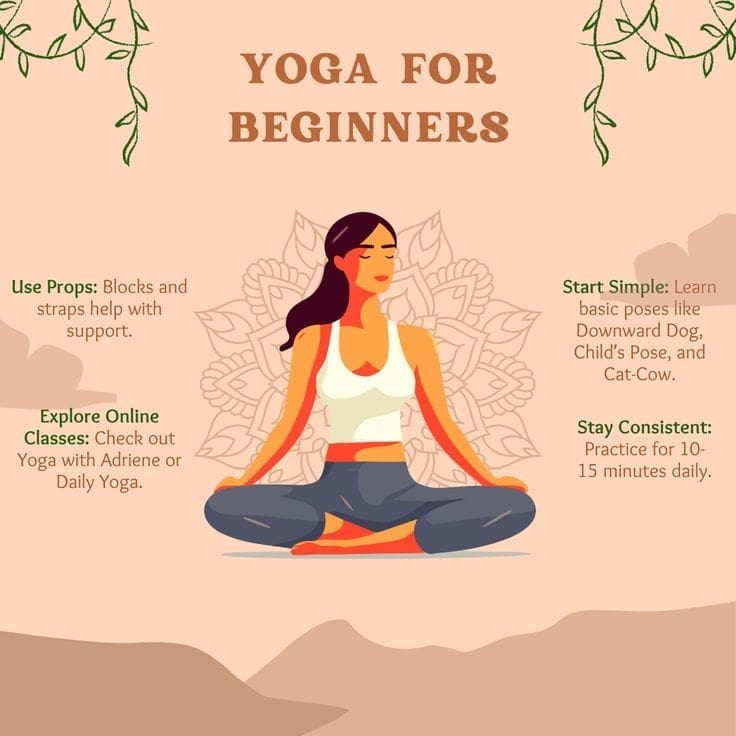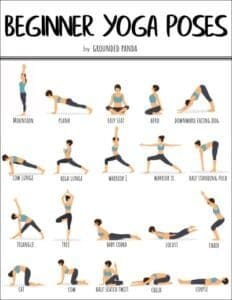Yoga poses for flexibility can make everyday tasks—like bending, reaching, or sitting—feel easier and more natural. Whether it’s bending down to tie your shoes, reaching for something in a high cabinet, or sitting comfortably for long periods, flexibility plays a significant role in your overall movement and comfort. In this article, you’ll discover various yoga poses that can enhance your flexibility and help you feel more at ease in your body.
Understanding Flexibility
Flexibility refers to the range of motion in your joints and muscles. It is essential not only for preventing injury but also for improving overall physical performance. When your body is flexible, daily activities become easier, and you may even find that your posture improves.
Benefits of Flexibility
There are numerous benefits to being more flexible. Here are some of the key advantages you can expect:
- Reduced Risk of Injury: Improved flexibility helps prevent strains and sprains by allowing your muscles and tendons to handle greater ranges of motion.
- Enhanced Performance: Whether you engage in sports or simply wish to improve your physical activities, better flexibility can lead to enhanced performance.
- Decreased Muscle Soreness: Stretching helps alleviate tightness in muscles, which can lead to a reduction in soreness after workouts.
- Improved Posture: Greater flexibility contributes to better alignment and posture, helping you sit and stand more effectively.
Understanding these benefits can motivate you to incorporate flexibility routines into your daily life.
Introduction to Yoga for Flexibility
Yoga is an excellent practice for improving flexibility. It combines meditation, breath control, and various poses to enhance physical and mental well-being. While some people may think yoga is only for those who are already flexible, the truth is that yoga can help everyone, regardless of their current level.
The Role of Breath in Yoga
As you practice yoga, you’ll learn that breath plays a critical role in enhancing your flexibility. Deep, controlled breathing can help you relax into stretches and hold poses longer, ultimately allowing you to achieve a more profound sense of flexibility.
Essential Yoga Poses for Flexibility
Let’s take a look at specific poses that can help you increase your flexibility. Incorporating these into your routine, whether at home or in a studio, can make a significant difference.
1. Downward Facing Dog (Adho Mukha Svanasana)
This foundational pose helps stretch your hamstrings, calves, and shoulders, contributing to overall flexibility.
- How to do it:
- Start on your hands and knees, with your wrists directly under your shoulders and your knees under your hips.
- Spread your fingers wide and press firmly into the ground.
- Tuck your toes under and slowly lift your hips up and back, straightening your legs while keeping your heels pressing toward the floor.
- Hold for 5-10 breaths, relaxing into the stretch.
2. Butterfly Pose (Baddha Konasana)
This seated pose focuses on your hips, groin, and inner thighs. It’s an excellent option for opening up your hip joints.
- How to do it:
- Sit on the ground with your legs stretched out in front of you.
- Bend your knees and bring the soles of your feet together, letting your knees fall open to the sides.
- Hold onto your feet with your hands and gently press your knees toward the ground.
- Breathe and hold the position for 1-3 minutes.
3. Cat-Cow Pose (Marjaryasana-Bitilasana)
This dynamic flow between two poses warms up the spine and is crucial for maintaining flexibility in your back.
- How to do it:
- Begin on your hands and knees, like in Downward Facing Dog.
- Inhale, arch your back (Cow Pose), and gaze upward.
- Exhale, round your back (Cat Pose), tucking your chin to your chest.
- Repeat the flow for 5-10 cycles.
4. Seated Forward Bend (Paschimottanasana)
This pose stretches the entire back and hamstrings, making it a fantastic option for improving flexibility.
- How to do it:
- Sit with your legs extended in front of you.
- Inhale and lengthen your spine, reaching your arms overhead.
- Exhale and hinge at your hips to fold forward, reaching for your feet.
- Hold for 5-10 breaths while relaxing into the stretch.
5. Low Lunge (Anjaneyasana)
A low lunge is excellent for opening the hips and stretching the hip flexors, which are commonly tight in many individuals.
- How to do it:
- Start in a standing position and step forward with your right foot while dropping your left knee to the ground.
- Ensure your right knee is directly above your ankle.
- Keep your chest lifted and press your hips forward.
- Hold for 5 breaths on each side.
6. Pigeon Pose (Eka Pada Rajakapotasana)
Pigeon Pose is a popular choice for increasing hip flexibility and opening the groin area.
- How to do it:
- Begin in a high plank position and bring your right knee forward, placing it behind your right wrist.
- Extend your left leg behind you, keeping your hips square.
- Fold forward over your right leg, resting your forehead on the ground or on stacked hands.
- Hold for 5-10 breaths before switching sides.
7. Forward Bend (Uttanasana)
A standing forward bend provides a good stretch for the hamstrings and back, promoting overall flexibility.
- How to do it:
- Stand tall with your feet hip-width apart.
- Inhale and raise your arms overhead; on the exhale, hinge at your hips and fold forward.
- Allow your knees to bend slightly if needed, and hang your arms freely toward the ground.
- Hold for 5 breaths, allowing your body to relax deeper into the stretch.
8. Triangle Pose (Trikonasana)
Triangle Pose increases flexibility in the legs and opens up the hips and shoulders.
- How to do it:
- Stand with your feet wide apart, and turn your right foot out 90 degrees.
- Extend your arms parallel to the floor and lean your torso toward your right leg, lowering your right hand to your ankle or a block.
- Reach your left arm up to the ceiling, and gaze at your left hand.
- Hold for 5-10 breaths and repeat on the other side.
9. Bridge Pose (Setu Bandhasana)
Bridge Pose works wonders for your back and promotes openness in your hips.
- How to do it:
- Lie on your back with your knees bent and feet hip-width apart on the ground.
- Press your feet into the mat and lift your hips toward the ceiling.
- Clasp your hands under your back and hold for 5-10 breaths, focusing on the stretch in your hips and chest.
10. Spinal Twist (Supta Matsyendrasana)
Spinal twists help increase spinal flexibility and relieve tension in your back.
- How to do it:
Creating a Routine
Incorporating flexibility-inducing yoga poses into your routine doesn’t have to be daunting. Here are some tips to help you establish a practice:
Frequency
Try to dedicate at least 3-4 days a week to your flexibility routine. Regular practice will yield better results than infrequent sessions.
Duration
Start with a 15 to 30-minute session where you focus on a series of poses. This duration is manageable, especially if you’re super busy.
Listen to Your Body
Pay attention to what your body needs. If a stretch feels too intense, ease out of it and find a comfortable position. Flexibility takes time, so be patient with yourself.
Combine with Other Forms of Exercise
You don’t need to limit yourself to yoga. Consider incorporating flexibility exercises into your other workouts, like running or cycling.
Tips for Improving Flexibility
As you work on your yoga practice for flexibility, here are some additional tips to enhance your results:
Warm Up Properly
Always warm up before diving into deep stretches. Simple movements like arm circles and gentle twists can prepare your muscles.
Focus on Your Breathing
As mentioned earlier, breath control is essential. Take deep, intentional breaths as you stretch; this will help relax your muscles and improve your experience.
Use Props
Don’t hesitate to use yoga props like blocks, straps, or blankets to assist you in reaching deeper stretches while maintaining safety.
Set Realistic Goals
Keep your expectations in check. Flexibility varies greatly among individuals, so set achievable goals for yourself and celebrate small victories along the way.
The Role of Meditation and Mindfulness
Yoga isn’t just about the physical practice; the mental benefits are equally important. Integrating mindfulness and meditation into your routine can further enhance your flexibility practice.
Finding Your Center
Before beginning your yoga practice, take a moment to find your center by sitting quietly and focusing on your breath. This ensures that your mind is clear, allowing you to engage fully in your yoga poses.
Visualization Techniques
Visualization can be a powerful tool. Imagine each body part becoming more flexible as you hold a pose. Picture yourself stretching deeply as you breathe, and you may find it easier to relax into the practice.
Incorporating Flexibility into Daily Life
Flexibility doesn’t have to be confined to your yoga mat. You can integrate it into your everyday routine in various ways.
Stretch During Breaks
If you have a sedentary job or spend long hours sitting, take a moment to stretch during breaks. Simple neck rolls, shoulder stretches, and hamstring stretches can keep your body flexible and reduce tension.
Engage in Activities that Promote Flexibility
Many activities can help improve flexibility, such as dancing, martial arts, or swimming. Engaging in different forms of movement can complement your yoga routine.
Conclusion
Improving your flexibility through yoga poses can lead to enhanced physical performance, reduced risk of injury, and a greater sense of well-being. By incorporating these yoga poses into your routine, you have the opportunity to create a more flexible body and mind. Remember to focus on your breath, listen to your body, and enjoy the process. You’re on your way to a more flexible and comforting existence! By practicing these yoga poses for flexibility regularly, you’ll begin to notice greater ease in movement and a more comfortable body.”
Frequently Asked Questions
1. What are the best yoga poses for flexibility?
Some of the best yoga poses for flexibility include Downward Dog, Butterfly Pose, Pigeon Pose, and Seated Forward Bend. These poses help stretch various muscle groups and improve your overall range of motion.
2. Can beginners do yoga poses for flexibility?
Yes! Yoga poses for flexibility can be adapted for beginners using props like blocks or straps. Consistent practice helps gradually increase flexibility over time.
3. How often should I practice yoga for flexibility?
Practicing yoga poses for flexibility at least 3–4 times per week is ideal. Short, consistent sessions can deliver better results than occasional long ones.
Disclaimer
The content is purely informative and educational in nature and should not be construed as medical advice. Please use the content only in consultation with an appropriate certified medical or healthcare professional



